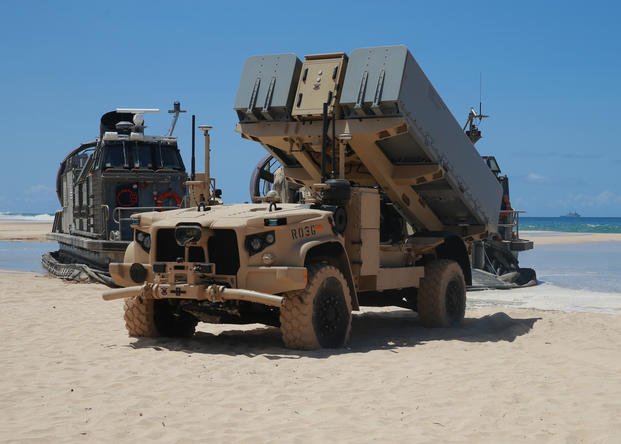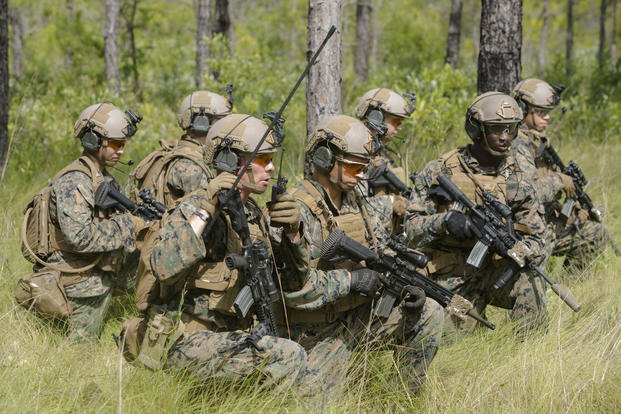The Commandant of the Marine Corps provided an update to Force Design 2030 on Thursday, signaling the Marines’ commitment to remaining globally responsive, lethal, and resilient in the face of evolving challenges. The update provides both a status update for the current status of Force Design as well as a roadmap for where the Corps is going.
What is Force Design 2030?
Force Design 2030 is the Marine Corps' plan to modernize how it fights. Think of it as a total overhaul to keep Marines ahead of enemies who use drones, long-range missiles, and cyberattacks. The goal is simple: stay fast, lethal, and hard to hit in places like the Pacific islands. It focuses on new gear, smarter units, and working tightly with the Navy and joint forces.
Force Design in Review

The update starts with a look back at progress since last year’s guidance. It’s broken into real-world action, unit changes, new weapons, and support systems.
Marines have tested new tactics in big exercises. In BALIKATAN 25, I MEF practiced hiding small teams on islands, using NMESIS (Navy-Marine Corps Expeditionary Ship Interdiction Systems) to sink ships, MADIS (Marine Air Defense Integrated Systems) to shoot down drones, and G/ATOR (Ground/Air Task-Oriented Radar) radar to spot threats. They trained with Japan and the Philippines. Exercises like TALISMAN SABRE and RESOLUTE DRAGON sharpened precision strikes and base defense with allies. ATLANTIC ALLIANCE 25 was the biggest amphibious drill in the Atlantic in years, practicing distributed operations with NATO partners.
Unit structure got tweaks. Two Marine Littoral Regiments (MLRs) are now in III MEF: 3d MLR is fully operational since 2023, 12th hits that mark in 2026. These units are built for island fighting with advanced sensors and missiles. The 4th Marines stays as a beefed-up infantry regiment. MEUs now carry the same high-tech gear as MLRs. Infantry battalions added a Fires and Recon company for drones and rockets, and squads went back to 13 Marines, including a drone operator. Notably, the Marine Corps recently created a new Attack Drone Team to hone these skills.
New weapons are being fielded across the field. Including the aforementioned NMESIS anti-ship missiles: six launchers delivered, heading to 18 per battery by 2033. HIMARS (High Mobility Artillery Rocket System) status: all 10 batteries complete. G/ATOR radars: 60% fielded by end of 2025. Organic Precision Fires and loitering munitions for infantry will start arriving in 2026. F-35 jets: 11 squadrons are done with more transitioning. MQ-9A drones fly recon over the Pacific. 3D printing labs (12 big ones, 25 small) let Marines conduct additive manufacturing to make parts on site.
Air defense is ramping up. MRIC (Medium-Range Intercept Capability) stops cruise missiles, three batteries coming soon. MADIS on vehicles: 20 delivered. L-MADIS on light trucks: 10 in 2026. Bases received counter-drone systems, and every unit will soon have portable anti-drone kits to address the ever evolving threat.
Doctrines are updating. Expeditionary Advanced Base Operations (EABO) and Stand-in Forces concepts are becoming official guidance. Bases are modernizing barracks and defenses. Recruiting and retention hit record highs. Training now includes AI, drones, and joint operations.

Where the Marine Corps is Going
This next section maps the future: better movement, deadlier weapons, tighter joint networks, smarter logistics, and constant learning.
Maneuver and mobility mean moving fast across sea, land, and air. The Corps wants 31 amphibious ships minimum. New landing craft are in development. Ground vehicles: Advanced Recon Vehicle for scouts, Amphibious Combat Vehicle (257 fielded), JLTVs (over 5,000 delivered), and ultra-light trucks. Aviation spreads out with distributed ops using KC-130s, CH-53s, and MV-22s.
Lethality gets upgrades. NMESIS and HIMARS will work in jammed environments. A new rocket launcher is coming. Infantry experiments continue. Drone teams will hunt targets. F-35s pair with XQ-58 unmanned wingmen. Long-range missiles expand strike options.
Joint kill webs link sensors to shooters faster. In order to improve these kill webs - new command systems will speed decisions. MQ-9 drones will receive better Artificial Intelligence (AI) integration. Aviation assets will get more flexible targeting tools.
As has been the case since Force Design was first promulgated, logistics will remain a major highlight going forward. Logistics in contested environments focus on keeping Marines supplied when enemies try to cut off traditional sea and air routes. The Corps is expanding its Global Positioning Network with prepositioned ships loaded with gear in the Indo-Pacific, Norway, and on Maritime Prepositioning Force vessels to fix current shortfalls and speed up resupply. Autonomous systems will start taking center stage: the Autonomous Low-Profile Vessel (also known as the “ALPV”) acts as an unmanned supply boat, while Tactical Resupply UAS drones and the Medium Aerial Resupply Vehicle deliver critical items like ammo, fuel, and medical supplies to forward teams without risking manned aircraft. Advanced Logistics Analytics will use AI to crunch data from sensors and predict needs, then reroute shipments in real time to dodge threats and keep the fight going. This setup cuts reliance on big, vulnerable convoys and ensures even small, dispersed units stay in the fight longer.
Education has, and always will be, a critical element to keeping the Marine Corps lethal. Continuous learning keeps the Corps sharp. The update maintains that learning “shapes the force.” Lessons from exercises will feed directly into tangible changes. Technology will move from the lab to the field faster. And last, but not least, feedback directly from the Fleet Marine Force will drive priorities.

Why This Matters
Force Design isn’t just a way to show off new gadgets, but rather it is survival. Pacing threats like the People’s Republic of China, and others, can increasingly strike from further away and jam communications. Marines must operate inside their reach, deny sea lanes, and support the fleet. These changes mean smaller, faster units that sense threats, strike first, and don’t need massive supply lines. For the average Marine, it means better tools, smarter training, and a Corps built to win the next fight, not the last one. The world is watching the Pacific. The Marine Corps is making sure it’s ready.














